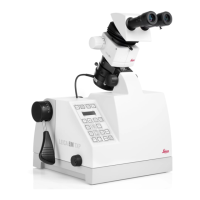Page 39 Operating Manual Leica EM TXP 10/10
10. Useful hints
10.1 Recommended sample size
For polishing, we recommend preparing samples with a size up to 60mm² maximum
as the polishing inserts diameter is 30mm. Preparing larger samples may result in the
polishing foils quickly wearing which would influence the quality of the surface as well
the lead-time.
10.2 Diamond disc cutter
The diamond disc cutter should only be used for hard and
brittle material (e.g. glass, silicon etc.) or hard and brittle
samples with inclusions of a small amount of ductile materials
(e.g. copper, gold etc.) Using the diamond disc cutter for large
ductile samples (copper, aluminium, etc.) would smear the
cutting area of the diamond disc, which will result in the cutting
edge wearing rapidly. Use an appropriate cut-off wheel instead.
Clean the diamond disc cutter with a commercially available dressing stone from time
to time.
10.3 Diamond miller
To achieve the best-milled surface quality the use of the diamond miller is
recommended. However, please bear in mind:
glass or glass fibre reinforced material will physically damage the diamond
miller
material containing iron, cobalt, nickel, manganese, chromium, tungsten,
tantalum, titanium and zirconium it will result in the cutting edge wearing
quickly. Where appropriate, use a tungsten carbide miller instead.
10.3.1 Surfacing of ductile materials and hard polymers
The lead time to prepare the surface of such materials can be significantly reduced
using the diamond miller in conjunction with the cooling system (water+ droplets of
liquid soap), slow (manual) E-W movement with the lever (7) and choosing a step
size between 0.5µm and 1µm. A surface finish produced in this way allows the use of
3µm followed by 1µm (and if necessary 0.3µm) aluminium oxide foils afterwards,
instead of higher grade foils.

